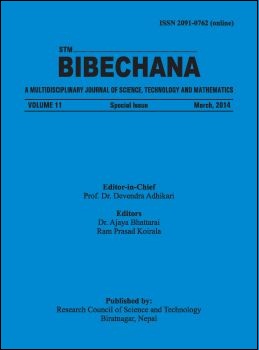Dye-sensitized solar cells sensitized with natural dye extracted from Indian Jamun
DOI:
https://doi.org/10.3126/bibechana.v11i0.10377Keywords:
Dye Sensitized Solar Cells, ZnO, Jamun natural dyes, ElectrolyteAbstract
Dye sensitized solar cell (DSSC) is a device which absorbs light from the sun with a layer of dye molecules and directly converts into electric energy. DSSCs based on ZnO have drawn attention worldwide due to their low cost and easy preparation techniques compared to conventional silicon based photovoltaic devices. Silicon based solar cells were the most popular before the emerging of dye-sensitized solar cells. These silicon based solar cells devices have dominated photovoltaic industry until now.
The objectives of this study is to make DSSC using ZnO on ITO coated glass substrate as anode and characterize the DSSC properties such as conversion efficiency, short current density, open circuit voltage, and fill factor. ZnO thin films have been prepared on Indium tin oxide (ITO) glass substrate. These films were used to construct ITO/ZnO/Natural Dye/C/ITO, DSSCs with natural anthocyanin sensitizer extracted from wild Jamun fruits. The cells show open circuit voltage (Voc) of 0.58V, short-circuit current (I sc) of 1.66 mA and 0.58 fill factor (FF) with an conversion efficiency (η) of 1.23%.
DOI: http://dx.doi.org/10.3126/bibechana.v11i0.10377
BIBECHANA 11(1) (2014) 34-39
Downloads
Downloads
Published
How to Cite
Issue
Section
License
This license enables reusers to distribute, remix, adapt, and build upon the material in any medium or format for noncommercial purposes only, and only so long as attribution is given to the creator.




